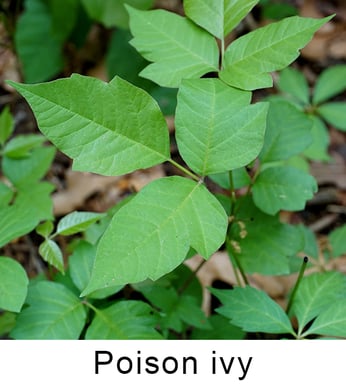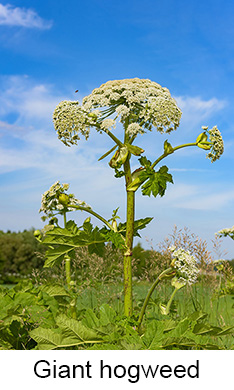
With good weather families can finally enjoy the outdoors! But that can quickly be ruined by poison ivy or giant hogweed. These plants look deceivingly harmless, but in reality they can cause dangerous rashes. Read on for tips on how to keep poison ivy and hogweed from ruining your time outside.
Prevention
 The best way to enjoy the outdoors without the nuisance of these plants is preventing exposure to them. By teaching your children about them and how to avoid them, they can safely enjoy a hike without you having to worry. This old saying is the best way to remember, “Leaves of three, let them be!” While there are many plants out there with leaf clusters in threes, poison ivy and poison oak have three distinguishing leaves, making this saying an easy way to remember and avoid them.
The best way to enjoy the outdoors without the nuisance of these plants is preventing exposure to them. By teaching your children about them and how to avoid them, they can safely enjoy a hike without you having to worry. This old saying is the best way to remember, “Leaves of three, let them be!” While there are many plants out there with leaf clusters in threes, poison ivy and poison oak have three distinguishing leaves, making this saying an easy way to remember and avoid them.
With poison ivy, you’ll see a stem with a larger leaf at the end and two smaller leaves on the sides. All three leaves will have pointed tips, and can be notched or have smooth edges. You can also see clusters of greenish-white berries or green and yellow flowers on poison ivy.
Giant hogweed is a bit different and can look an awfully lot like other harmless plants. Giant hogweed can grow to be several feet tall, but it starts out much smaller. The easiest way to identify giant hogweed is to look for purple blotches and white hairs on the stem. If it has both of these, there's a strong chance it's giant hogweed. Queen Anne’s lace, cow parsnip and Angelica are all harmless, similar-looking plants to giant hogweed, but are much smaller with smooth stems.
Treatment
 Even after you’ve taught your children about how to identify these plants, they can still accidentally be exposed to them and have symptoms. Here’s what to do in those cases.
Even after you’ve taught your children about how to identify these plants, they can still accidentally be exposed to them and have symptoms. Here’s what to do in those cases.
Poison ivy rash is caused by an allergic reaction to an oily resin called urushiol. This oil is in the leaves, stems and roots, and can be transferred via contact with the skin or even through smoke if the plant is being burned. Your child may develop a rash, itchy skin or blisters. Often, these symptoms won’t start until 12 to 72 hours after your child has come in contact with the oil, so it’s important again that your child knows how to identify the plants so you can treat them right away.
For poison ivy exposure, wash the area with lukewarm water and dish soap. Thoroughly clean clothing or items that may have also come in contact with the plants. The oil can stick to many surfaces, including gardening tools, golf clubs, leashes and even a pet’s fur. If blisters form, leave them alone and let the healing process do the work. Short, lukewarm baths in colloidal oatmeal (available at most drugstores) can help ease the itch and irritation. A cool compress made with a clean washcloth can also help. The rash is not contagious and, contrary to popular belief, it does not spread. If the rash is not improving after seven to 10 days, or you think it may be infected, call your child’s pediatrician.
The danger of giant hogweed stems from its sap, which is present on all parts of the plant. The sap of the giant hogweed plant is phototoxic, which means contact with the plant sap prevents the skin from protecting itself from sunlight, which leads to a serious skin inflammation. This is something to be cautious of not only from direct contact with the plant, but if doing any kind of yard work that could cause the sap to spray or get on any tools that others could later touch.
To minimize the damage, immediately wash the affected area with soap and cold water and contact your child’s pediatrician. Cover the skin to protect it from sunlight for the next few days with clothing and sunscreen.
Resources
As always, if you suspect your child has a rash and you have questions, don’t hesitate to call your child’s pediatrician. We’re happy to answer questions.
The Wisconsin Poison Center is also a great resource. Read our blog post here about when to call the Wisconsin Poison Center (1-800-222-1222).
It’s also important to report giant hogweed or a mass amount of poison ivy to your local authority, like the Department of Environmental Conservation, so they can properly remove it and everyone can enjoy the outdoors without the danger.
Children's Wisconsin Resources

Written by
Emilee Yamdagni
, MD
Pediatrician
Related Stories
No related articles found.



